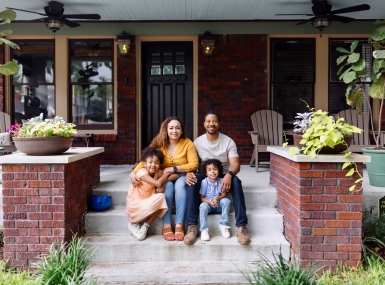Fulton County moving far away from jail’s troubled past
Diversion will be key to shrinking Fulton County Jail population
Fulton County, Ga. wants its jail to be a roadmap, not just a building.
That map leads to a future of promise, far from the decrepit conditions that brought on nine years of federal oversight, ending just 18 months ago. Right now, there’s no specific destination, but it is in the general direction of better overall financial health for the county and its citizens’ well-being.
The path is already a long way from inmates sleeping in hallways because the cells that didn’t lock properly were packed full. Even out from under the federal consent decree that ended a 2004 lawsuit, Commission Chairman John Eaves isn’t satisfied with its breathing room — he wants to keep moving ahead to the point where the county is a national leader.
“We believe we can be a model for criminal justice reform,” he said. “Before, arresting people and putting them in jail was the first — and, in many cases, the only — option. Now we’re moving to a point where there are a lot more ways you can handle an offender.”
The consent decree, with 120 stipulations, was based on three main issues — overcrowding, understaffing and squalid conditions. The problems weighed the commission down both financially and emotionally, but ultimately inspired action. It was the third consent decree on the jail since 1982.
“If there’s a silver lining to a consent decree, it’s that you don’t have a choice except to act,” Eaves said. “You face the threat of fines or being put in jail yourself,” if you don’t improve, and indeed Eaves and Sheriff Ted Jackson faced a contempt case in 2014.
That case was dismissed after the county finally replaced the door locks and outsourced inmates to other jails to bring the population down below the mandated 2,500-inmate limit stipulated in the consent decree. The entire women’s population is currently housed in the county’s Union City Jail.
Building Momentum
Roughly $59 million later, a major renovation fixed many of the building’s structural problems. Though it had taken eight years to get to the point where these issues were being addressed, there was sympathy for the journey from those most likely to be watching — the Southern Center for Human Rights, which brought the original case against the jail on behalf of inmates there.
“I’m not sure if it’s like trying to steer a really big boat, maybe that’s why it’s taken so long,” said Mary Sidney Kelly, an investigator and paralegal with the Southern Center who has worked on the jail case. “They’ve made a lot of progress in the last year. Now you have a functioning building that that handle the number of people who are housed there.”
Joan Garner, a county commissioner who came into office in the fifth year of the consent decree, saw the effort the county has taken in recent years, building up speed and momentum.
“It took a lot of planning to get to this point,” she said. “Sometimes it was a new way of thinking. Every department that is touched by the justice system meets once a month to look at the jail, the courts, how they intersect. Now we’re at a point where we can implement changes.”
For Eaves, the hard part was getting the County Commission to commit to fixing the jail when plenty of other needs and projects called out for county funding.
“The real political will was in making it a priority, and I made it priority number one,” he said. “Commissioners have a lot of competing priorities and spending that kind of money on something that most of our citizens don’t deal with on a regular basis is a big commitment. When they have health concerns or want to go to the library at certain times, those are more important to them than improving the jail.”
More than a Lockup
“At any time, between 40 percent to 70 percent of our inmates have problems with mental illness,” Eaves said.
A series of accountability courts — drug courts, veterans’ courts, mental health courts — are helping divert potential inmates into treatment programs that are more effective and less expensive than incarceration. Every inmate receives a mental health assessment during intake, and law enforcement officers are receiving crisis -intervention training to help identify and manage situations in which they respond to someone with a mental illness.
“It meant a lot of our partners in the justice system had to rethink their historic strategies, but now the system has options it didn’t before,” Eaves said. “You didn’t have a mental health court before, all you could do was throw someone in jail and keep them off of the streets, but they wouldn’t get any better. Now we have the capacity to put more emphasis on diversion programs every year.”
“So far, our drug treatment programs have the lowest recidivism rates, but the metal health programs treat the most people.”
Kelly, from the Southern Center, agreed with that tactic for lowering the jail population.
“Jail is not an effective place to address behavioral health problems,” she said. “You can do it more effectively and less expensively in the community.”
Annual bookings in the jail have plummeted, hitting close to 26,000 in 2015 after reaching more than 45,000 in 2010. And there’s more room for improvement.
Garner is excited about the integration of new population- management software that can help make the disposition of cases more efficient, cutting down on pre-trial detention time.
“We have superior court, state court magistrate court juvenile court, they all have their unique ways of operating,” she said. “I see a more consolidated approach to operating that will fit together better.
Now Hiring
While inmates are now experiencing improved conditions, one aspect of the consent decree remains unresolved. The sheriff’s office did not move for termination of the consent decree — but the commission did — because staffing levels were still low. Fixing that is going to be harder than repairing a building or building diversion programs, and it’s caused, in part, by the unique political layout that makes Fulton one of 20 counties in the Atlanta metropolitan region, which offers a lot of competition for labor.
“I wouldn’t call it intractable, but it’s a difficult program to solve,” Kelly said. “They’re competing with other counties and private employers for applicants. It’s still an outstanding issue.”
Eaves pegs the turnover rate at 30 percent.
“It’s a little dispiriting to know that a third of the people you hire and train won’t be around that long, but I understand it,” Eaves said. “It’s a high-stress job; there’s always the potential for violence or verbal harassment. After a few years there, if you have a chance to work somewhere else, I can’t fault someone for taking it. The jail is not an easy or glamorous assignment.”
Eaves’ best solution is to streamline the hiring process, which can take as long as two months.
“That’s too long to fill some of these high-turnover jobs,” he said. “There’s nobody waiting on the sideline for these jobs, so the soonest we can vet and train them, the better.”
Where to Go from Here
Eaves and his staff have toured other county jails throughout the country, hoping to learn and adapt programs that have been successful elsewhere. They have include Bexar County, Texas; Johnson County, Kan.; Salt Lake County, Utah and King County, Wash.
“Everywhere I’ve gone, I’ve seen something that would work in Fulton County,” he said. “Nothing that worked well somewhere else wouldn’t work for us.”
It’s the next step in what he sees as a race for the county to be a national leader on local criminal justice issues that, like the jail improvements, took some time to speed up, but that time investment is an asset for Fulton County.
“The national conversation on justice reform was happening on the local level long before,” Eaves said. “Many states and counties are having this discussion and I feel like we have a five-, six-year running start on it.”
As jail alternatives develop and population drops, Eaves likes the jail’s chances of comparing favorably to peer counties’ per capita spending and crime rates.
“Considering where we started, I feel good about what we’ve done and where we’re going,” he said.
Attachments
Related News

CMS announces extended funding application period to improve the continuity of care for justice-involved individuals
On September 27, the Centers for Medicare & Medicaid Services announced $106.5 million in state planning grants aimed at improving healthcare continuity for individuals transitioning from incarceration.

Congress reintroduces bipartisan disaster mitigation bill to support homeowners
On March 5, Disaster Mitigation and Tax Parity Act (H.R. 1849) was introduced to the U.S. House of Representatives. This introduction follows the late-January introduction of the same bipartisan legislation in the Senate (S. 336). NACo previously supported this legislation and continues to advocate for its passage to support county resilience efforts.

U.S. Senate introduces bipartisan Disaster Assistance Simplification Act
On March 5, the bipartisan Disaster Assistance Simplification Act (S. 861) was introduced in the U.S. Senate to streamline the federal disaster aid process for survivors. NACo endorsed this legislation, which would make it easier for county residents to access critical assistance after disasters.
